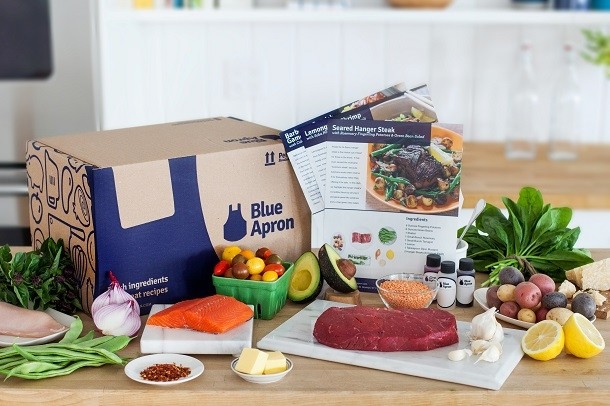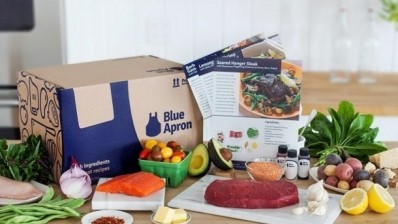What does Blue Apron’s roller-coaster stock price mean for the meal kit category’s future?

Blue Apron’s stock spiked slightly more than 13% on Monday after analysts with several of its underwriters tagged the stock as a good deal with outperform and buy ratings and predicted share price targets of $10 to $11. This is up from the $6.55 a share that Blue Apron closed at on Friday – a whopping 40% below its initial public offering of $10 on June 29.
RBC Capital Markets’ Mark Mahaney justified the difference between his projection and the stock’s current reality by noting that Blue Apron, and by extension the entire meal kit category, is operating in a multi-billion dollar market that is “nearly all offline and taking spend away from both traditional grocers and restaurants.”
As one of the largest players in the meal kit space, Oppenheimer’s Jason Helfstein argues that the company is well positioned for rapid and long-term growth because it can “use its scale advantage to offer quality, convenience and choice” even in the face of competition from Amazon and traditional grocers.
Tuesday evening when the stock market closed, the company had fallen slightly from $7.82 at opening to $7.47 when the market closed, suggesting that there could still be some volatility in the stock even with the boost from the positive analyst reviews.
Despite these glowing initial reviews of Blue Apron’s IPO, Rich DeNardis, the chief revenue officer for competing meal kit company Home Chef, fears that the initial negative reaction to Blue Apron’s IPO could have a longer-term damaging impact on the category overall.
“Blue Apron’s IPO being a little rocky out of the gate” could “spook” some investors, so that “there is not likely to be another big venture investment in the space any time soon,” DeNardis told FoodNavigator-USA.
He explained that this is “a potential silver lining” for established players in the category, such as Home Chef, but that it “will be difficult for some folks that are a little bit smaller, subscale players that might be looking to raise $50 million plus rounds to really get to the point of scale” necessary to survive in the category.
“Subscale companies that are reliant on subsequent venture capital rounds in order to sustain themselves just won’t be able to do so in the absence of that venture capital funding being available,” resulting in a bit of a “shake-out” in the category, which has become increasingly crowded and competitive in recent years.
“I do think there is likely to be some winners and losers in the space,” he added.
Blue Apron doesn’t reflect the entire category
But beyond that, he does not think that Blue Apron’s IPO – whether up or down long term – is indicative of the meal kit category’s potential as a whole.
“I wouldn’t say that Blue Apron’s financials are a mirror of what you would see if you looked at any other meal kit service, which is the same as you could say for any industry where one company may be approaching operations slightly differently than another,” he explained.
As such, he is confident that Home Chef, for example, will continue to grow and thrive along with the rest of the established meal kit space regardless of what happens to Blue Apron.
He attributes in part the success of his, and other players’ companies, to their ability to carve out a niche segments of the market.
“I think from day one there has been points of differentiation around some of those services. So, a service like Blue Apron or Plated is a little more focused on introducing folks to new flavors that are trending. A service like Green Chef or Sun Basket are focused on organic and really that sort of tip-top consumer who will pay premium prices for organic certified products,” and Home Chef offers a “customer first approach” that includes offering more choices, flexibility and familiar flavors that consumers know and love, he said.
Retaining consumers in a competitive field
But providing a unique twist on subscription meal kits alone is not enough to make it, DeNardis said. Rather, he said, companies also must generate sustained, repeat business, which can be an elusive goal.
“Some of the reasons we have heard that folks churn on other [meal kit] programs and keep coming back to ours is that we offer more choice and our offerings are more family friendly,” he said, explaining, "the other products that are out there are too fancy for their kids and so, ultimately, it came down to even if the parents liked one service better, if the kid enjoyed the sort of flavors Home Chef meals have more, because they are a little less exotic,” then the family will follow the child’s choice.
DeNardis also said Home Chef retains consumers by offering a strong value proposition in that the meals are large enough for parents to share with their children and still have plenty for everyone to eat.
Finally, he said, “exceptional customer service also drives consumers to stick around.”









